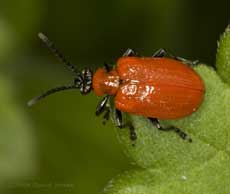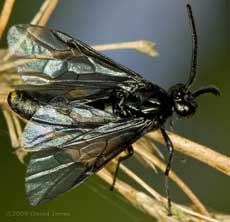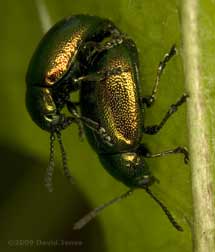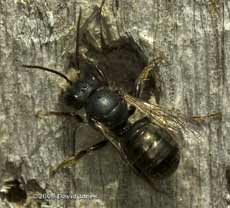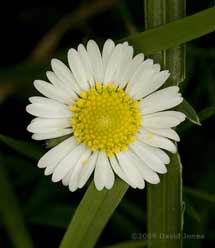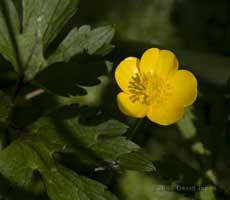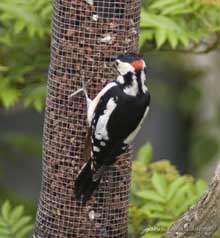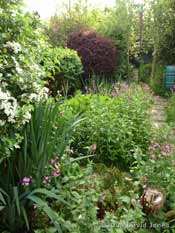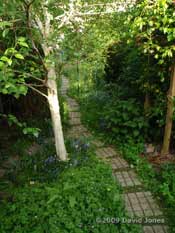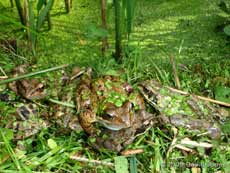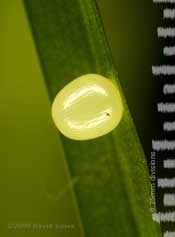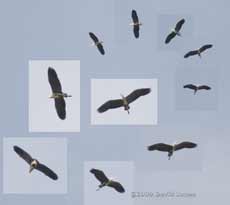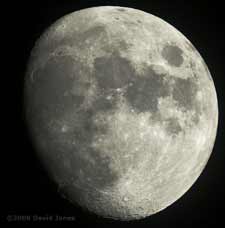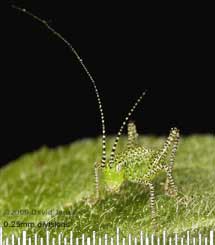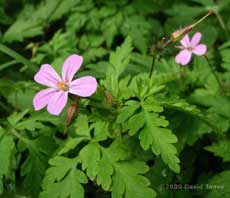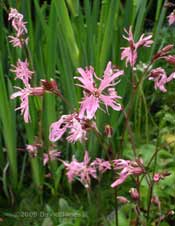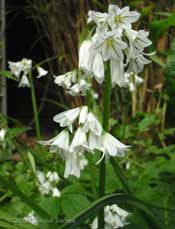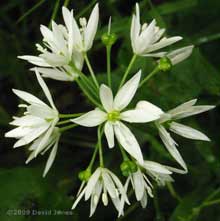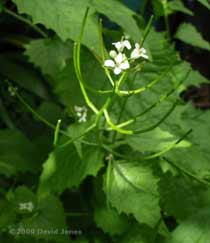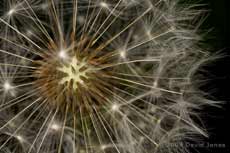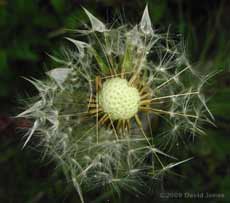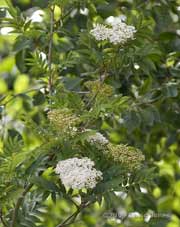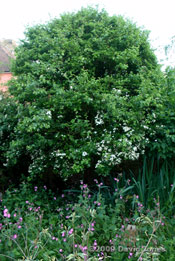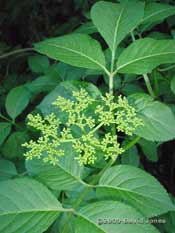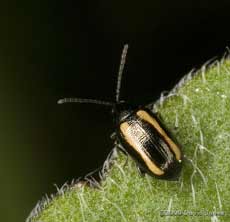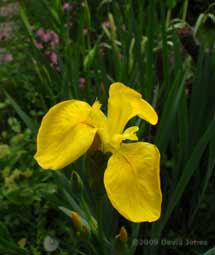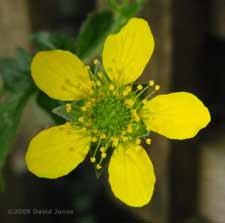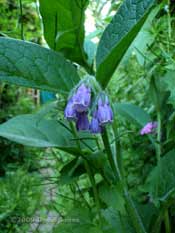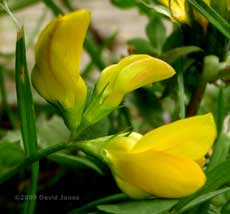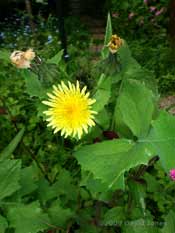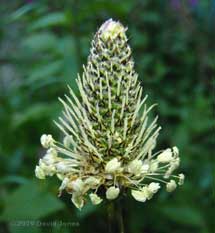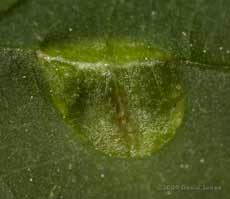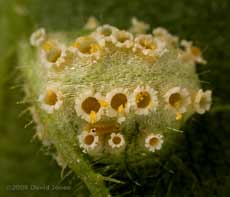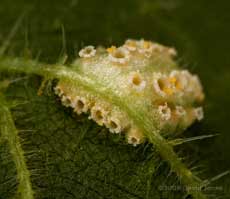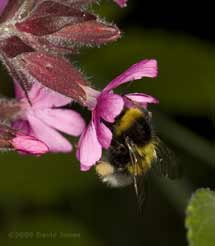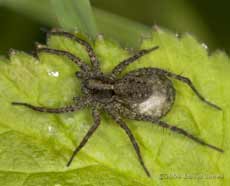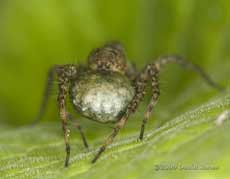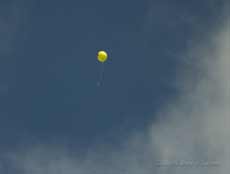Go to the last entry on this page .....Go to previous entry1 - 11 May - It has been a mixed beginning to the month both for me and the weather. While I've struggled to find the energy to do things, the temperatures outside have failed to reach the norm for early May. We've had some bright weather, but too much cloud, and this has been reflected in what has been a quiet time for insect spotting.
Having said that, the month started off with a bit of brightness that is less welcome - a Lily Beetle (Liloceris lilii) which is attracted into the garden by the Snake's Head Fritillaries.
Whenever the sun shines, the Rhadinocerea micans sawflies continue to be very active. Although they usually appear black in photographs, there is a distinct blue colouring that shows up when they are in flight. On the ninth there must have been at least ten flying about - the most I've seen at one time. I wondered if I'd be able to spot any mating, but nothing seen so far.
The only insect mating I have seen so far this month involved a pair of small craneflies (in a spot inaccessible to my camera) and these small beetles on a Dandelion leaf (9 May).
At the bee hotels, activity continues to reflect the weather, so that things were slow during this period, except when the sun shone. However, I did notice what looks like a different species there in the first few days of the month - I have yet to attempt an ID.
On 7 May, the first Ragged Robin came into flower, by the side of the big pond,
as did the first Daisy of the year.
While I saw them in flower in a nearby garden on 1 May, we had to wait until the 9th for the first Field Buttercup to flower in our more shady conditions.
On the 5th we had one of those occasional, but very welcome visits from a male Greater Spotted Woodpecker. As usual, it was spotted from our bedroom window (the feeder cannot be seen from a downstairs window) and required a dash downstairs to grab the camera! Otherwise, things have become quite mundane around the feeders for the moment, with only a couple of Goldfinches bringing extra colour, and no fledglings so far.
Yesterday I took advantage of a nice day to do a bit of 'estate management'! This year I've decided to do as little cutting of the ground cover as possible, just to see what come up - so far so good. However, I do need to make sure that the path down the garden, and a couple of restricted access points to the big pond remain clear.
This was the view down the garden yesterday evening, with the Red Campion now becoming the dominant flower over much of the garden,
and looking back towards the house from the West Wing. Much of the slope down from this end of the garden is now covered with Herb-Robert (Geranium robertianum) - the small pink flowers.
One of our special joys now comes in the form of a beautiful, happy little grand-daughter who has discovered the joy of being able to walk. It seems as if we are having a bit of an influence on her because when she come to visits she already knows what she wants to see when we go down the path. First, it's across to my corner of the dining room to check out the tv images of the nestboxes (what will she think when the boxes are empty!), and then its out into the garden, down the path to watch the bees, and any birds around the Hawthorn and the feeders (she is already switched on to listening to the birds).
Finally, a special treat is to sneak up on the frogs that come out onto the side of the ponds, and often end up in a pile as they try to find the optimum sunbathing position. Yesterday there must have been around twenty in this small area, although the picture shows just six.
While our grand-daughter wasn't with us yesterday, I had a treat of a different sort. So far this month there have been precious few butterflies in the garden, several Large Whites, 1 Holly Blue, 1 Orange Tip, and a couple of Speckled Woods.
Yesterday, while I was doing my gardening, the only Speckled Wood in sight landed on a blade of grass by the side of the path and laid a single egg - the first time I've seen one doing so in the garden. It's a good excuse not to cut any more grass for a while!
I haven't seen any Buzzards so far this month, but yesterday this Heron caught my eye as it started spiralling up in a thermal over us. While we often see Herons pass by, I don't recall seeing one doing this over us before. It went up very high before heading off west.
Finally, not really garden news, but a couple of pictures as a result of a request from a young friend of ours who is making a career change to take up teaching. He wondered if I had any pictures of the moon that he could use in a lesson.
As it happened, that evening (the 4th) the grey skies parted and the moon appeared in a rather misty looking sky, but clear enough to set up the camera and get this view.
In a subsequent e-mail he wondered about pictures of planets (!!??). As it happens, Saturn is in a really good position in the night sky at the moment, high in the sky and just west of due south just after dark. As for my first picture ever of Saturn - you'll definitely need to look at the large version to see that this is not just a spot! I do have a small telescope, bought from a car boot sale and needing TLC, but that gave a far better view. When I have sorted it out I shall have to look into a camera adaptor for it.
Today it is brilliantly sunny under cloudless skies, but rather windy, and the forecast for the next few days is grim, with heavy rain. Mind you, the surface soil is now very dry and hard to dig into - so the garden needs watering. Also, if there wasn't rain in the forecast I would need to top up the ponds this week.
12 May - After I spent much of yesterday carrying of essential work on our veranda, determined to complete it before the heavy rain forecast for today, today has been bright and sunny, if quite windy. At least the job is done now, and this evening the skies have turned grey, so perhaps the rain is on its way!
Just one picture for this entry, my first sighting of a Speckled Bush Cricket nymph (Leptophyes punctatissima) this year, on a Mint plant. This is just three days earlier than the first sighting in 2008.
16 May - The rain promised for the night of the 12th didn't materialise, and we had to wait until the night of 14-15th to get a real downpour along with high winds. Since then the weather has been blustery, with just the occasional shower, and sunny intervals. It has remained quite cool, with the temperature just reaching 14C over the last two days. While the birds seem to be finding plenty of larvae for their chicks, the conditions continue to keep insect sightings to a minimum in the garden, and when you do spot something the wind moves it on. If the conditions don't suite us, they are certainly encouraging the plants.
The Herb Robert is thriving like never before,
and the Ragged Robins are much better than last year, although they really live up to their name in this picture, taken on the morning of the 15th, after the heavy rain.
The Triangular Garlic is having a mixed season so far, The plants next to the workshop are in full flower now, while the plants under the Hawthorn have produced just a few flowers, and there is no sign of more on the way.
In contrast, the Wild Garlic (Ramsons) under the Hawthorn have done well, with new plants having appeared this Spring. Their flowers are now past their prime. A friend of ours is going to be clearing some Ramsons for her front garden. When that happens they will be heading into our garden.
The Garlic Mustard plants are also coming to the end of their flowering one, producing long, curved seed pods
As I've said before, I think their flowers can look great (and are appreciated by the solitary bees), and their seed heads are a marvel of design,
until the rain descends!
The Rowan is going to have a really good covering of flowers this year (hopefully, lots of berries as well) -the first flowers opened today. Unfortunately these are at the top of the tree so you need to look out of our bedroom window to see them.
The Hawthorn's flowering has been a bit disappointing again this year. Unfortunately we do need to keep the tree trimmed as it is rather close to the house, and that inevitably takes away some of the tree's flowering buds, although I thought I'd kept that to a minimum this last year.
Another plant that is way behind at the moment is the Elder. There are only a few inflorescences of flower buds on the Elder next to the Hawthorn. This plant seems to have put a great deal of its energy into producing lush foliage instead. The best developed buds are actually on a second, much smaller plant next to the Ivy tree.
I'll end with just a single insect, spotted two days ago. This was identified for me several years ago as a Flea Beetle (Longitarsus dorsalis) which is a nationally scarce species associated with Ragwort plants. I think we have just two Ragworts here this year, both in the early stages of growth. I hope they flower well as they are also needed for some of the Solitary bees that live here!
22 May - After another cool period the weather has improved again over the last few days, and we have now had two days when the temperature reached just over 18C. It hasn't been all clear skies, and soon cools when the sun hides behind a cloud, but the sunshine has had an effect on the garden.
Yesterday our first Flag Iris flower opened. Today the count was up to three and there are quite a few buds that will open over the days to come.
Yesterday also brought the first Wood Avens flower or more correctly, flowers as at least a dozen appeared. Today there must be at least 30 open.
Several other plants have flowered over the last few days. Amongst the Garlic Mustard plants is a single Comfrey plant, which I had forgotten about until its large leaves pushed their way past the Garlic Mustard.
On the opposite side of the path to the pond the Bird's Foot Trefoil (Lotus corniculatus) which did well last year looks as though it is thriving. There are lots of flower buds on it but I found this group of fully formed flowers hidden under the foliage.
We occasionally get an example of a Common Sowthistle in the garden, and this year one has grown next to the far end of the big pond. It appears to produce just one flower each day, and that has closed by the early afternoon. On that basis it looks as though this one started flowering three days ago.
A very different flower is presented by the Ribwort (or Narrow-leaved Plantain - Plantago lanceolata). It produces this flower spike, with white Stamens and rather inconspicuous anthers that protrude like thin fingers around the spike. As they get older the stamens will turn brown and the spike becomes quite drab.
Another flower has appeared today, although I have yet to identify it. It's a small plant, no more than about 9cm tall, and is growing under the Sparrow feeder which is filled with a mixture of millet and canaryseed, both of which are grasses. The other feeders have Sunflower kernels and niger seed.
I'm sticking to my policy of doing as little in the way of gardening this year, and We are very pleased with the way things are working out (so far!). However, I do need to do the odd bit of pruning, especially along the 'hedgerow that is now developing along the fence, and today I also cut away some of the Stinging nettle stems that drooped over the path up to the West Wing. As usual every pruning session is followed by an inspection and today's was no exception. The bits I removed from the Willow, Elder and Hawthorn were surprisingly insect free, and so were the Nettle stems. However, several of the Nettle leaves had a secret in store when I turned them over.
While the top of the leaf would have small, sunken areas like this (in this case measuring about 5mm across),
On the underside were structures like this.
In this second picture you can see the way that the structure seems to have grown under one of the leaf's veins and forced it up. I think that the swollen area is the nettle's reaction to a fungal infection. That fungus has produced orange spores that are being released through the opening and can be seen over much of the nearby surface.
There have been plenty of bumblebees about today and I have discovered that we have at least two bumblebee nests here, one under the tiles of a small roof at the rear of our kitchen, and at the other end of the garden under the metal shed, in a place used in past years. I have not yet discovered a carder bumblebee nest here - I'm still looking! There were also Honey Bees visiting today, but I saw no activity at all at the solitary bee hotels. The fluctuating weather hasn't been kind to the solitary bees this last month with periods of cloudy weather and just occasional sunshine.
I've been ignoring the spiders this Spring. Some of the most visible as you walk down the garden are the wolf spiders (identity unknown) that can be seen sunning themselves on logs, the water butt and leaves. At other times they are wandering hunters.
I often watch the courtship that goes on as the males attempt to approach the females, waving their pedipalps furiously as they do so. Sheila and I watched this happening today, while at the same time several females could be seen nearby, carrying egg cases which are attached to their spinnerets.
This picture shows more clearly how the case is held well clear of the surface as the spider moves about.
Finally, I continue to point the new lens skywards in order to try and record over flights of mybitoftheplanet by interesting birds etc. While several Herons have flown over us since I saw the one soaring in the thermal, but I haven't seen any Buzzards lately. While I wait I take advantage of aircraft, and helicopters to practice focusing and following moving 'targets'. However, today's picture is of something much smaller, a helium filled balloon that must have been a couple of hundred feet up, still climbing and heading east. It reminds me how, when I'm out on my kayak off the Lizard coast I often find deflated balloons both on the shore and amongst floating seaweed. A lot of concern has been expressed about how these can be mistaken as jellyfish and eaten by marine animals. Apparently nearly all these balloons are meant to be biodegradable (to the extent that they break up into smaller and smaller fragments), but the long time scale of this process means that they can be in the water for quite a while. That balloon was heading towards London - I wonder if it will make it to the Thames estuary. I hope to catch up with adding the large images during the weekend.
Click on images to see larger versions |
|
